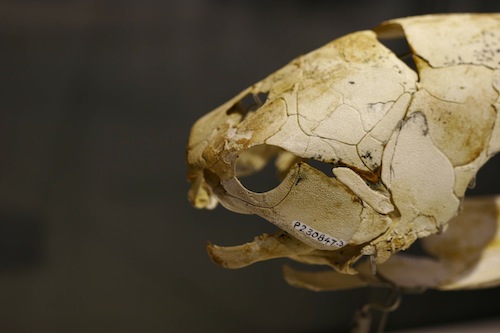
Kate Trinajstic
Favourite Thing: Discovering new fossils. It is fantastic to crack open a piece of rock and see something no-one has ever seen before.
My CV
School:
Our Lady of Mercy Paramatta (NSW)
University:
Bachelor of Science (Biology) Murdoch University 1996 PhD(Geology) University of Western Australia 2000
Work History:
Editor of Dinonews Western Australian Museum 2000 Research Fellow (Biostratigraphy) University of Western Australia 2001-2008 Curtin Research Fellow Curtin University 2009
Employer:
Chemistry Department Curtin University
Current Job:
Palaeontology specializing in early vertebrate evolution and soft tissue preservation
Me and my work
I’m a paleontologist who is trying to understand how we evolved an internal skeleton. I am using the synchrotron in France to examine different types of mineralised tissues such as bone, cartilage and dentine, and why different groups of vertebrate animals have different types of mineralised tissues. I am also looking at how bone grows and as the bone grows how muscles remain attached.
Major gaps remain in our knowledge of the origin of novel vertebrate structures such as the mineralised skeleton; jaws and internal fertilisation. The fossil group I study are palcoderms, the oldest verterbates with jaws and paired pelvic and pectoral fins  .
.
Fossils provide direct evidence for major evolutionary transformations, as shown for example by our recent discovery; that of demonstrated live birth, providing the earliest evidence of advanced reproductive structures including the presence of fossil embryos and an umbilical cord  .
.
We named this fossil after Sir David Attenborough 
Me and my team are working to overcome the limited amount of information fossils provide (becasue usually only the bones are preserved  )
)
through an unprecedented 3D study,
using CT scanning 
and new synchrotron imaging of fossils  ,
,
allowing us to reconstruct fossil anatomy at the sub micron level  .
.
This accuracy, not previously possible enables the construction of integrative hypotheses linking molecular and morphological evolution
My Typical Day
I dont have a typical day, that’s what I love! Sometimes I am doing field work seraching for fossils, other days discussing research with my team and students or preparing fossils from the rock, using the micro-CT scanner or writting a paper. everyday is an adventure
What I'd do with the money
I’d like to increase the fossil collection to loan to schools and provide material for the microscopes in schools program developed by WA’s chief scientisit
My Interview
How would you describe yourself in 3 words?
Inquisitive, Persevering, Enthusiastic
Who is your favourite singer or band?
David Bowie
What is the most fun thing you've done?
Presented my research to Sir David Attenborough after naming a fossil after him
If you had 3 wishes for yourself what would they be? - be honest!
That I could find a complete conodont in Australia, I had x-ray vision so i could see which rocks had good fossils in them without having to break the rocks, that i could see in living placoderm
What did you want to be after you left school?
Egyptologist
Were you ever in trouble in at school?
yes
What's the best thing you've done as a scientist?
co-discovered the earliest vertebrate embryos which showed placoderm (armoured fish) gave birth to love young
Tell us a joke.
What do you call a blind dinosaur? I don’t think he saurus (saw us)
Sports followed
cricket
Favourite team
Australia
My profile link:
https://beryllium.imascientist.org.au/profile/katetrinajstic/
 Print this profile
Print this profile








 .
. .
.
 )
)
 ,
, .
. Print this profile
Print this profile